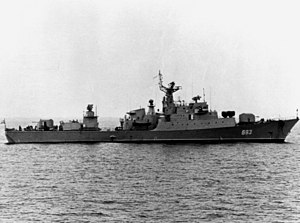
| |
| Class overview | |
|---|---|
| Name | Koni class (Project 1159) |
| Operators | |
| Preceded by | Mirka class |
| Succeeded by | Gepard class |
| Built | 1975–1988 |
| Completed | 14 |
| Active | 5 |
| Lost | 1 |
| General characteristics | |
| Type | Frigate |
| Displacement |
|
| Length | 95 m (311 ft 8 in) |
| Beam | 12.8 m (42 ft 0 in) |
| Draft | 5 m (16 ft 5 in)[2] |
| Propulsion | |
| Speed | 27 knots (50 km/h; 31 mph) |
| Range | 3,300 km (1,800 nmi; 2,100 mi) at 26 km/h (14 kn; 16 mph) |
| Complement | 110[1] |
| Sensors and processing systems |
|
| Armament |
|
The Koni class is the NATO reporting name for an anti-submarine warfare frigate built by the Soviet Union. They were known in the Soviet Union as Project 1159. 14 were built in Zelenodolsk shipyard between 1975 and 1988. They were originally intended to replace the older Riga-class frigates, but were instead chosen as a design for export to various friendly navies. The Koni I sub class were designed for European waters and the Koni II were made for warmer waters.[3] One ship was retained by the Soviets in the Black Sea for training foreign crews. Only a few of these vessels remain in service today.
The Romanian Tetal-class corvettes were similar.
- ^ a b c "Koni class - Project 1159". FAS.org. 2000-09-07. Archived from the original on 2016-04-28. Retrieved 2007-01-04.
- ^ Couhat Jean. Combat Fleets of the world 1982/1983 Their Ships, Aircraft, and Armament Paris: Editions Maritimes et d'Outre-Mer, 1981 ISBN 0-87021-125-0 Library of Congress Catalog Card Number: 78-50192 Pg.2
- ^ "Koni Class - Project 1159". globalsecurity.org. 11 July 2011. Retrieved 6 October 2014.